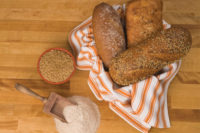Crackers industry provides innovative, healthy options

When you think of crackers, what comes to mind? Your favorite brand? Your favorite topping? The saltines that your mother fed you with soup when you were sick as a child? Or perhaps that time your best friend crammed a dozen of them into their mouth and then tried to whistle? It may just be some hummus, or even salmon and cucumber with cream cheese and chives. For me, I go to wine and cheese.
However you like yours, crackers are a staple in snacking, and have been since they were created over 200 years ago. While the dictionary defines a cracker as a thin, dry biscuit, we know they are so much more than that.
Everyone loves crackers. In fact, according to the most-recent crackers market report produced by Mintel, 92 percent of American consumers purchase crackers. It’s easy to see why—not only are they incredibly versatile and convenient, but they also enjoy a healthy reputation. When they are paired with a little bit of protein or some fruit, crackers are quite literally the foundation for a healthful snack.
Crackers are also a great way for people to ensure they get the USDA-recommended six servings of daily grains. A single serving of whole-grain crackers will provide up to 2.5 grams of fiber, up to 10 percent of the daily value of magnesium (a mineral that supports a healthy immune system), and protein in the range of 2–2.5 grams (see http://grainfoodsfoundation.org/infographics/healthy-choice-infographics/common-sense-servings). Grain foods like crackers contribute less than 15 percent of all calories in the total diet, while delivering greater than 20 percent of three shortfall nutrients—dietary fiber, folate and iron—and greater than 10 percent of calcium, magnesium, and vitamin A. Essentially, it is the company the crackers keep that could paint an unhealthy picture, not the crackers themselves.
At the Academy of Nutrition and Dietetics’ 2017 Food Nutrition Conference & Expo (FNCE) in Chicago, the Grain Foods Foundation presented the findings of our most-recent study, “Building a Better Sandwich,” that came to the same conclusion about bread. The study, a modeling analysis, was conducted to assess the energy and nutrients contributed from all sandwiches in the diets of American children and adolescents. It used government data from the National Health and Nutrition Examination Survey (NHANES), as well as USDA Typical Food Patterns, to assess how Americans currently eat. We found that the ingredients inside the sandwich—not the bread itself—are the most-significant drivers of calories, fat and sodium. Although this study does not cover crackers, the same principles apply.
Recently, there has been a push to make crackers healthier—but keep in mind that no one wants a cracker that tastes like sawdust. While the rise of a health-conscious public is a good thing, people will ultimately revert to eating something that tastes good.
To that end, there has been a burst of innovation lately in the cracker industry. We are now seeing bold flavors and unusual combinations to attract consumers. Remember the gluten-free crackers of yesteryear? The first time I tried one, I was 100 percent sure I was eating a cardboard box. Now, gluten-free, whole-grain and multigrain crackers are enjoyable.
When the need to snack strikes, a hearty fiber-filled snack is what we need to pick us up. Crackers are a reliable source for the crunch we all need from time to time. They’re great on their own, but a little vegetable and protein can be used to elevate the taste experience and create a well-balanced snack. Crackers are our edible plates.
Looking for a reprint of this article?
From high-res PDFs to custom plaques, order your copy today!





